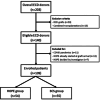Hypothermic Oxygenated Perfusion in Extended Criteria Donor Kidney Transplantation-A Randomized Clinical Trial
- PMID: 40294124
- PMCID: PMC12036954
- DOI: 10.1111/ctr.70166
Hypothermic Oxygenated Perfusion in Extended Criteria Donor Kidney Transplantation-A Randomized Clinical Trial
Abstract
Background: The role of machine perfusion after kidney transplantation (KT) in extended criteria donors (ECD) is unclear, and the current evidence in the literature remains controversial.
Methods: We present an open-label single center randomized trial where 109 patients undergoing KT with ECD grafts between January 2019 and December 2022 were randomized to receive kidneys treated with either hypothermic oxygenated perfusion (HOPE, n = 54) or static cold storage (SCS, n = 55) alone. The primary endpoint was the incidence of delayed graft function (DGF). The secondary endpoints included postoperative complications and graft function and survival in the first year after KT.
Results: The trial failed to meet its primary endpoint. DGF developed in 31 (57%) and 37 (67%) patients in the HOPE and SCS groups, respectively (p = 0.3). Posthoc analysis showed that HOPE was associated with a lower risk for DGF for grafts from donors aged 60 years or older (OR 0.32, 95% CI 0.12-0.87, p = 0.026) and in patients undergoing dual KTs (OR 0.22, 95% CI 0.06-0.87, p = 0.031).
Conclusions: HOPE does not reduce the rate of DGF after KT in ECD donors. However, HOPE appears to be associated with better outcomes in the case of older donors and dual KTs.
Keywords: delayed graft function; extended criteria donors; graft survival; kidney transplantation; machine perfusion.
© 2025 The Author(s). Clinical Transplantation published by Wiley Periodicals LLC.
Conflict of interest statement
The authors declare no conflicts of interest.
Figures
References
Publication types
MeSH terms
Substances
Grants and funding
LinkOut - more resources
Full Text Sources
Medical


